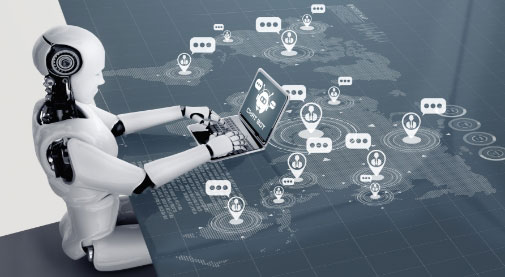Summarizing In!
Chatbots make brands more approachable and impactful while accommodating customers and businesses altogether in a bunch of ways. Be it the job of connecting with a customer representative, addressing concerns to support, producing a lead to get in touch with later, or request products and services, Chatbots support you through with all. Moreover, Chatbots nowadays are inspired by the potential of AI and have the capacity to initiate and implement multiple tasks that add substantial value to the organization, like streamlining the sales process, advancing workforce performance, and likewise.
Through Market Specs!
As per the forecasts, it could be known that the global Chatbot market size would reach the heights of USD 10.5 billion by 2026, from the USD 2.9 billion in 2020, at a CAGR rate of 23.5%. The key rationale behind the positive outlook of the chatbot market includes growth in need for 24/7 customer support at a more economical operational charge, boost in a locus on customer commitment through different channels, and preferments in technology coupled with rising customer demand for self-service operations, thus extending a competitive advantage to businesses.
Not only this, Chatbots have the potential to benefit companies and supplement value to their business processes in infinite ways. Have a look:
Chatbots can prove to be profoundly advantageous when it comes to addressing and welcoming shoppers on the website or applications, surmising the customer’s needs, rendering data based on inputs, forming leads based on the information furnished, connecting the visitor to a customer agent, and more.
Being packed with bountiful benefits, let’s check the types of Chatbots available in the market and what each type stands for…
Chatbots Categorized!
To go straight, it could be taken that chatbots are usually met up in two types, which are the major ones and in use/trend in present times. Also, the following two types of chatbots would mark a pleasant time when it comes to their development and wide acceptance all over the world –
Chatbots Driven By Rules:
Chatbots that employ simple boolean code to direct a user’s question are known as rule-based chatbots. Not only do these chatbots tend to be more modest systems, but they also operate on a preconceived premise that practices commands/rules to solve queries.
An easy true/false algorithm induces rule-based chatbots to interpret user queries and present the most appropriate and effective acknowledgment in the most intuitive way imaginable. But, they are incompetent of assuming the connection or the purpose of the human query and therefore cannot recognize language differences. Moreover, these chatbots are circumscribed to proposed commands, and if the customer entreats anything outside of those rules, the bot fails to respond rightly.
Chatbots Driven By AI:

Being more advanced and competent in perceiving open-ended inquiries, Conversational AI employs natural language processing and machine learning algorithms to grow smarter over time. As a result, they are more comparable to a real live agent that can develop and earn more abilities.
Apart from raising their functionalities and becoming smarter as time progresses, AI Chatbots can also learn new features and adapt as and when required. Programmed smart chatbots can gauge a website visitor’s sentiment and temperament to respond fluidly and dynamically.
The Functioning of AI-Powered Chatbots
AI powers online chatbots with two principal elements, namely machine learning and natural language processing, to learn and widen their capabilities and contribute more satisfying value to visitors.
Machine Learning serves as a base-level algorithm that does the task of directing systems regarding what to perform subsequently. Now, as the smart chatbot receives a prompt or user input, the bot examines the query’s content and surveys to produce the most appropriate and pragmatic response.
On the other hand, Natural Language Processing (NLP) has the capability to converse more readily with a human, without the visitor sensing like they are interacting with a machine, thereby producing highly practical and spontaneous communications. Put simply, NLP enables computer systems to recognize human language better, therefore identifying the customer’s purpose, sentiment, and overall demand.
The Hint to Choose the Best!
Chatbots, if employed wisely, can append substantial value to your business. Hence, it’s imperative to analyze a few prominent factors when opting for a smart chatbot for your organization. A few of those factors could be the extent of data required by the chatbot to process, the variations in questions the chatbot will undergo, the complexity and variables associated with providing solutions, and the abilities of the developers.
Depending on your business needs, you may weigh your options. For example, rule-based chatbots can efficiently manage manageable and direct queries. However, if you require your chatbot to administer extensive data, variables, and questions, the means to go would be an AI chatbot that learns through machine learning and NLP.
Wrapping Up!
With the surge in Chatbots adoption worldwide, it’s time to secure the power of Conversational AI in your business. This would help you render your clients the utmost satisfaction concerning time and quality resolution. Moreover, it would also lend you the privileges of a competitive edge over others in the market. At Teksun Inc, we furnish quality-driven services for Chatbots development and deployment—looking forward to integrating a Conversational AI in your business? Get in touch with us today!



